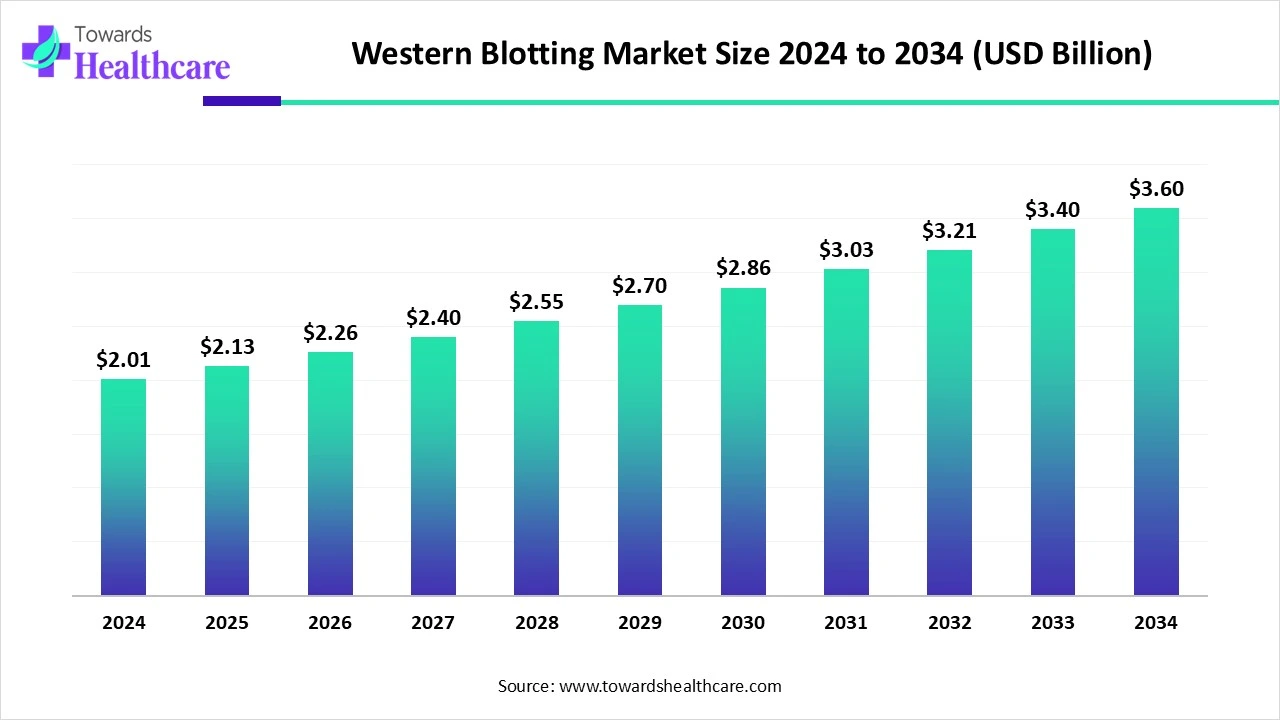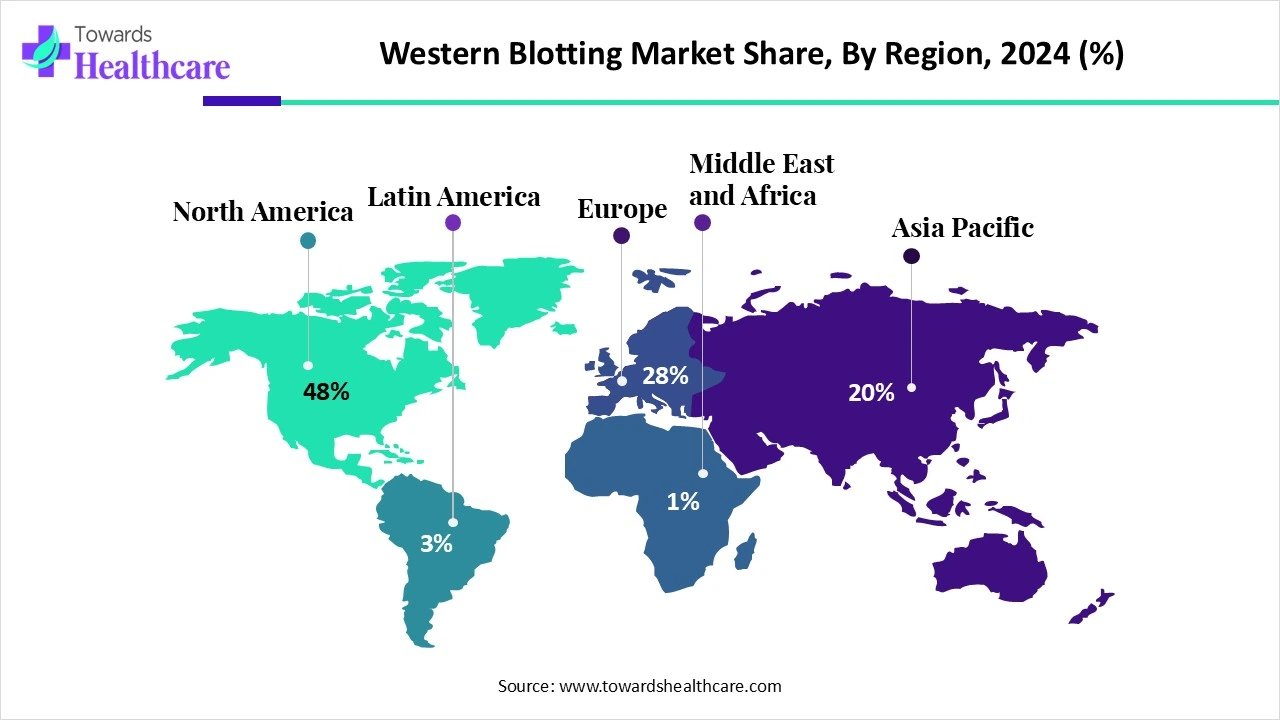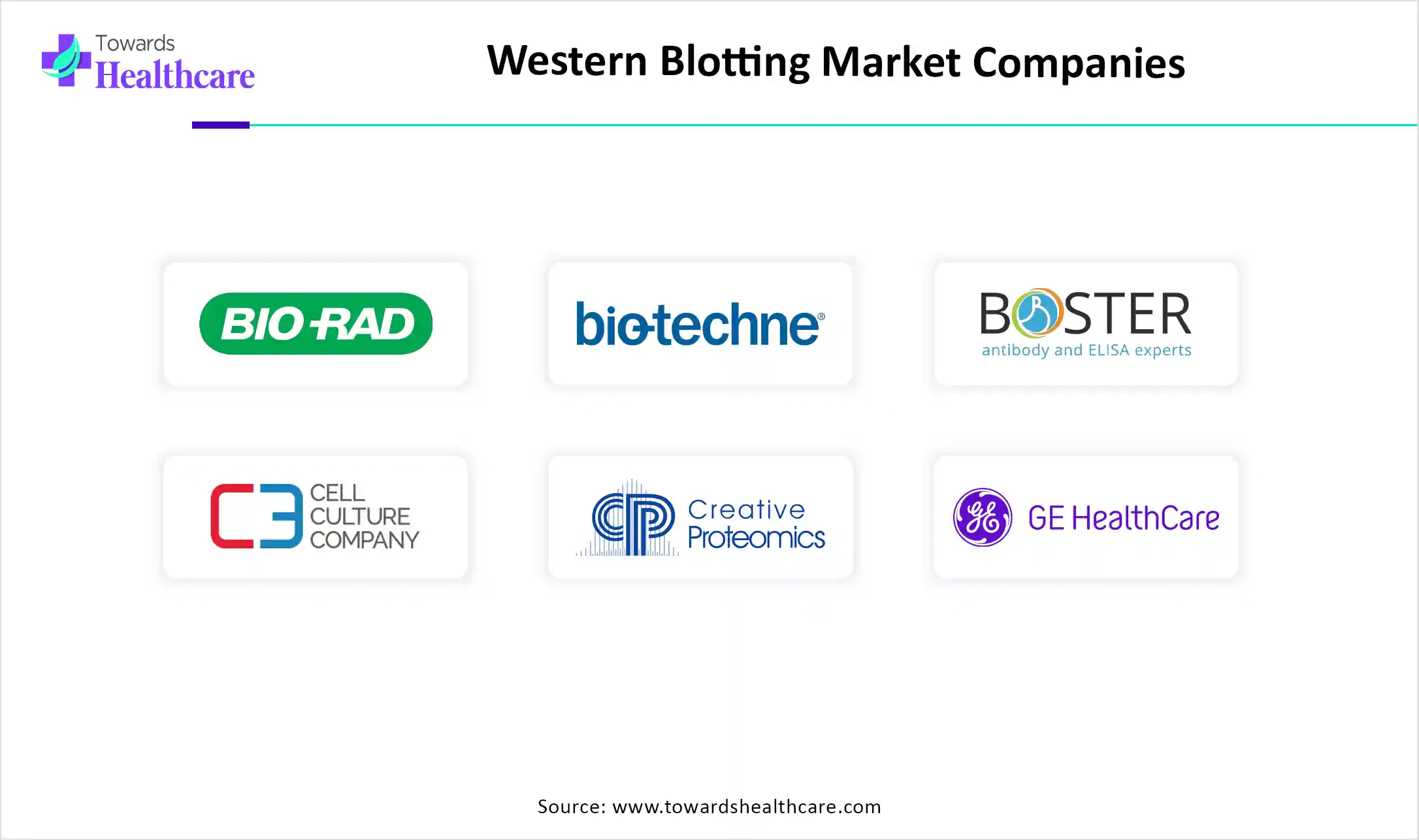November 2025

The global western blotting market size is calculated at USD 2.01 billion in 2024, grew to USD 2.13 billion in 2025, and is projected to reach around USD 3.6 billion by 2034. The market is expanding at a CAGR of 6.05% between 2025 and 2034.

The western blotting market is mainly driven by the rising prevalence of chronic disorders and growing research and development activities. The burgeoning pharmaceutical and biotechnology sector promotes the development and use of the Western blotting technique. The growing demand for early diagnosis and personalized medicines augments market growth. The future looks promising, driven by advancements in proteomics and the integration of AI/ML in Western blotting.
| Metric | Details |
| Market Size in 2025 | USD 2.13 Billion |
| Projected Market Size in 2034 | USD 3.6 Billion |
| CAGR (2025 - 2034) | 6.05% |
| Leading Region | North America share by 48% |
| Market Segmentation | By Product, By Application, By End-Use, By Region |
| Top Key Players | Bio-Rad Laboratories, Bio-Techne Corporation, Boster Bio, Cell Culture Company, Creative Proteomics, Cytiva Life Sciences, GE Healthcare, Ichor Life Sciences, Inc., Proteintech Group, Sarepta Therapeutics, Thermo Fisher Scientific, Zyagen |
Western blotting is a technique used to analyze individual proteins in a blood or tissue sample. This technique uses gel electrophoresis to separate a sample’s proteins based on their size, charge, and other characteristics. It offers numerous benefits over other techniques like ELISA. Western blotting allows the detection of several targets, semi-quantifies the protein of interest, and determines the size of the target protein.
Numerous factors govern market growth, including the rising prevalence of chronic disorders and growing research and development activities. The burgeoning biotech sector and advancements in proteomics augment market growth. The increasing investments and collaborations among academic researchers and key players promote the development of Western blotting. Government organizations launch initiatives to encourage early disease diagnosis.
Artificial intelligence (AI) can transform the Western blotting technique by introducing automation in the entire workflow. AI enhances efficiency and accuracy, as well as reduces manual errors during the experiment. It improves reproducibility and streamlines the entire process. It plays a major role in the detection and analysis of outcomes. AI-based detectors can decipher complicated protein patterns that are difficult for researchers. This reduces the time for data interpretation, enhancing the accuracy and precision of data. AI-driven software can revolutionize the image analysis process.
Rising Prevalence of HIV
The major growth factor of the Western blotting market is the rising prevalence of HIV/AIDs. The Western blotting technique is primarily used to detect anti-HIV antibody in a human serum sample. The UNAIDS reported that approximately 39.9 million people were living with HIV globally in 2023, with 1.3 million new cases. (Source - UNAIDS) Numerous government organizations make necessary efforts to access effective HIV prevention, diagnosis, treatment, and care. The UNAIDS also reported that $19.8 billion was available for the AIDs response in low- and middle-income countries as of 2023.
Lack of Skilled Professionals
The Western blotting technique is a labor-intensive protocol, requiring skilled professionals to perform such a complex experiment. Several low- and middle-income countries do not have sufficient skilled professionals to work on Western blotting. The lack of sufficient funding in such countries also restricts market growth.
What is the Future of the Western Blotting Market?
The future of the market is promising, driven by the growing need for miniaturization of the Western blotting technique. Advancements in Western blotting are made with the adoption of microfluidics techniques. Microfluidics results in faster analysis time, improved sensitivity, lower reagent consumption, and higher multiplexing capability. Miniaturization of the Western blot technique reduces sample wastage and enables the detection of minute amounts of samples. This decreases the overall cost of research and analysis. Microfluidic advancements overcome several challenges of the conventional Western blot technique. Furthermore, parallelization of multiple immunoassays can present future opportunities for researchers.
By product, the consumables segment held a dominant presence in the market in 2024. The segment dominated because of the availability of low-cost consumables. Consumables include kits and reagents, which are essential components of experiments. Numerous biotech companies provide customized consumables based on the research requirements of researchers. Consumables enable researchers to perform multiple experiments simultaneously. They contribute to the overall experimentation of Western blotting, driving sensitivity and specificity.
By product, the instruments segment is expected to witness significant growth in the market over the forecast period. Researchers require different instruments at various stages of the Western blot technique. They play a vital role in data analysis and interpretation. The integration of advanced technologies, such as AI and ML, boosts the segment’s growth. AI/ML can enhance the efficiency of instruments and accelerate the speed of Western blot analysis. Many instruments are user-friendly with digital displays, enabling researchers to focus on the essential data.
By application, the biomedical & biochemical research segment led the global market in 2024. This is due to growing research and development activities and the need for understanding disease mechanisms. Western blotting techniques are widely used to study disease progression and identify several protein targets involved in a disease. Based on the type and structure of protein targets, researchers develop novel drugs that bind to the targets in vivo. Several government and private organizations provide funding for conducting biomedical research.
By application, the disease diagnostics segment is expected to grow at the fastest CAGR in the market during the forecast period. The growing demand for early disease diagnosis and precision medicines augments the segment’s growth. Early disease diagnosis provides scope for healthcare professionals to effectively treat a disease at an early stage. The demand for point-of-care diagnostics is also increasing, due to the rising geriatric population and the increasing demand for home healthcare.
By end-use, the academic & research institute segment held the largest revenue share of the market in 2024. The segmental growth is attributed to growing proteomics research and increasing collaborations among academic researchers. The increasing collaborations enable researchers to access advanced tools and techniques related to Western blotting. The rising funding by government and private organizations supports research in academic institutions.
By end-use, the diagnostic centers segment is expected to expand rapidly in the market in the coming years. The availability of favorable infrastructure and suitable capital investments propels the segment’s growth. Diagnostic centers have skilled professionals who help in detecting chronic disorders using complex Western blot analysis. The increasing use of automated systems also contributes to the segment’s growth.

North America dominated the global market share by 48% in 2024. The presence of key players, increasing research investments, and the availability of state-of-the-art research and development facilities are the major growth factors of the market in North America. Government organizations provide funding for conducting biotech research. Advancements in proteomics technologies enable researchers to develop novel diagnostics and personalized medicines.
Key players, such as Thermo Fisher Scientific, Bio-Rad Laboratories, and GE Healthcare, are the major contributors to the market in the world. The National Human Genome Research Institute (NHGRI) announced an annual budget of approximately $663 million for FY 2025. The budget is allocated to various sectors, including research projects, research centers, and research training. (Source - Genome.gov)
The Canadian government announced an annual symposium by a leading research community, the Canadian National Proteomics Network, in October 2025. The government aims to develop an integrated strategy and an effective communication infrastructure to promote the development of a cooperative national research network.
Asia-Pacific is expected to host the fastest-growing Western blotting market in the coming years. The growing research and development activities and the rising prevalence of chronic disorders promote the market. The burgeoning pharma and biotech sector and the increasing number of startups contribute to market growth. Government and private institutions conduct seminars, workshops, and conferences to create awareness about advanced Western blotting and train individuals in the same.
The UNAIDS reported that approximately 1.4 million people are living with HIV in China, and women comprise around 23.7%. The Chinese government recently launched one of the largest and best-funded proteomics 30-year research initiatives with a multibillion-dollar investment.
The incidence of syphilis is increasing in Japan, accounting for 14,663 cases in 2024. Tokyo, Osaka, Fukuoka, Aichi, and Kanagawa were the top 5 cities with the highest number of syphilis cases. The demand for point-of-care diagnostics is rising due to the growing geriatric population. The Pharmaceuticals and Medical Devices Agency (PMDA) regulates the approval of PoC testing in Japan.
Europe is expected to grow at a considerable CAGR in the Western blotting market in the upcoming period. The rising adoption of advanced technologies and favorable government support drive the market. The growing need for early disease diagnosis and personalized medicines boosts the market. The growing proteomics research and increasing public-private partnerships foster market growth.
The UK government recently announced an investment of £11 million in six projects to increase early cancer diagnosis, including a blood test that promises to detect 12 common cancers. This promotes the development of Western blotting techniques. The UK Research and Innovation (UKRI), along with other research institutions, has collectively invested £200 million in precision medicine. (Source - UK Research and Innovation)
The Middle East & Africa are considered to be a significantly growing area in the western blotting market, due to advancements in genomics & proteomics and growing research and development activities. The increasing investments by government and private organizations and collaborations among key players contribute to market growth. The rising adoption of advanced technologies and the burgeoning biotech sector foster market growth. The growing demand for early disease diagnosis also potentiates the use of Western blotting.
Genetic disorders are a major public health concern in the UAE. It is estimated that 75 out of 1000 babies born in the UAE suffer from a birth defect of genetic origin. Thus, the UAE government makes healthcare innovation a national priority and invests heavily in Genetic Medicine research and infrastructure.
There are between 4,000 and 6,000 people, with an estimated 1 in 25 children affected by genetic disorders in South Africa. The South African Rare Diseases Initiative (RDAI) was launched by the government to create a more accessible healthcare environment for patients with rare diseases.

Kenneth Oh, Global Marketing Manager at Bio-Rad Laboratories, commented that the ChemiDoc imaging system enables researchers to capture Western blot and gel images from their benchtop with high sensitivity and unparalleled versatility. He also said that the latest addition offers class-leading sensitivity, all-LED illumination, and cloud connectivity, all within a small footprint. (Source - Technologynetworks.com)
By Product
By Application
By End-Use
By Region
November 2025
November 2025
November 2025
November 2025